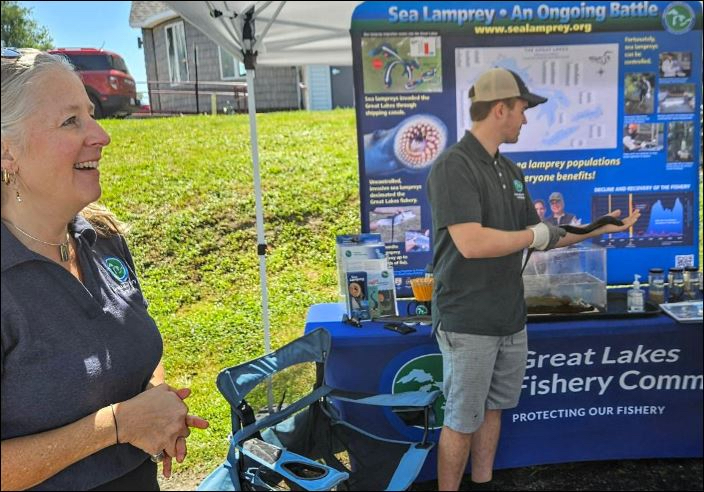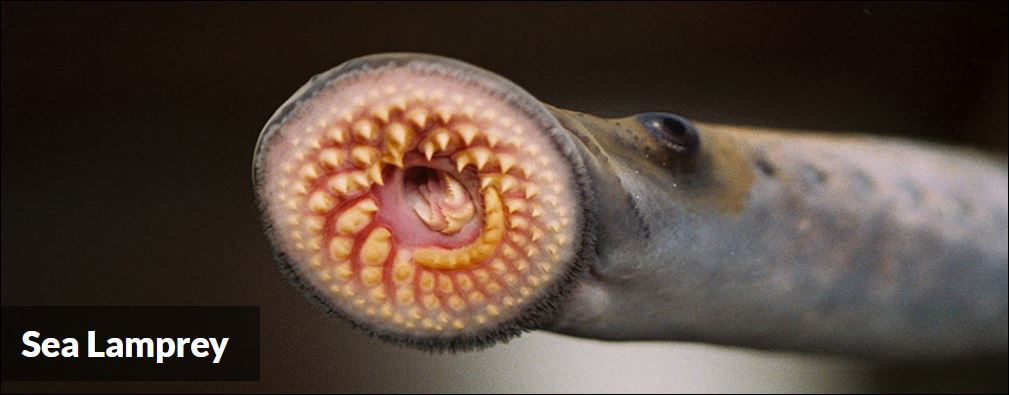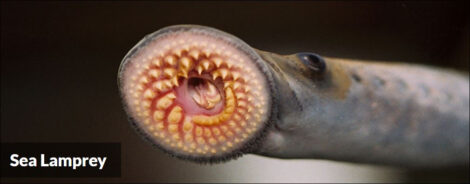Lampreys Thrive On Lake Erie Wildlife
- The Great Lakes Fishery Commission exhibit tent at the Northern Chautauqua Conservation Club Walleye Derby last weekend featured a live demonstration with sea lampreys. Photo courtesy of Forrest Fisher
- Measuring 12 to 18 in inches in length, sea lampreys are invasive parasites that feed on fish in Lake Erie and other Great Lakes, often killing the fish and decimating certain coldwater fish species if not controlled with lampricide treatments in our local streams. Photo courtesy of Great Lakes Fishery Commission

The Great Lakes Fishery Commission exhibit tent at the Northern Chautauqua Conservation Club Walleye Derby last weekend featured a live demonstration with sea lampreys. Photo courtesy of Forrest Fisher
A Great Lakes invader, sea lampreys (Petromyzon marinus) are parasitic fish native to the Atlantic Ocean, but entered the Great Lakes as an invasive species via sea-going ships.
Sea lampreys feed on other fish by sucking their blood and other body fluids. They have remained essentially unchanged for more than 340 million years, surviving through at least four major extinction events. They’re tough. The long and short of it is that sea lampreys kill fish; fish like Lake Erie steelhead, brown trout and lake trout — especially lake trout.
Their impact on the Great Lakes fish population is significant, with each lamprey capable of killing many fish over their 12-18-month feeding period. Sea lampreys attach to fish with their suction mouth and then dig their teeth into flesh for grip.
During the Northern Chautauqua Conservation Club Walleye Derby last weekend, the Great Lakes Fishery Commission provided a hands-on display with live sea lampreys in a small aquarium where a technician would allow the lamprey to attach to his hand. It was interesting to watch this demonstration.
Once securely attached, sea lampreys gouge their way through the scales and skin of coldwater fish species in the Great Lakes to feed on the body fluids of the fish. They do this by secreting an enzyme that prevents blood from clotting.

Measuring 12 to 18 in inches in length, sea lampreys are invasive parasites that feed on fish in Lake Erie and other Great Lakes, often killing the fish and decimating certain coldwater fish species if not controlled with lampricide treatments in our local streams. Photo courtesy of Great Lakes Fishery Commission
The GLFC folks there said this is like how a leech feeds off its host.
In their native Atlantic Ocean, thanks to co-evolution with fish there, sea lampreys are parasites that typically do not kill their host. In the Great Lakes, where no such co-evolutionary link exists, sea lampreys act as predators, with each lamprey capable of killing many fish. While sea lamprey resemble eels, they are not related and are set apart by their unique mouth: a large oral sucking disk filled with sharp, horn-shaped teeth surrounding a razor-sharp rasping tongue. These unique features make sea lampreys fascinating creatures to study and understand.
GLFC explained that the adult sea lampreys migrate into our streams, build crescent-shaped nests from rocks, spawn, and then die. After the sea lamprey eggs hatch, larvae drift to areas of soft sediment and burrow into the stream bottom where they filter-feed on micro-organisms and live for several years. The larvae then go through a metamorphosis, growing eyes and a suction-cupped mouth with barbed teeth, then migrate to the open lake as juveniles that feed as parasites on the coldwater fish. After 12 to 18 months of feeding, sea lampreys return to our freshwater streams to spawn, and the cycle begins again. To control their population in streams, GLFC provides a lampricide program, which involves the use of a chemical formula that specifically targets sea lamprey larvae, but is not detrimental to humans. This program has been effective for many years now, but depends on subsidized funding to continue.
Gotta love the outdoors.
CALENDAR
Aug. 7-8: Cabela’s National Walleye Tour Qualifier event, Dunkirk Harbor. Professional angler TV event. Weigh-in events are open to the public. Visit www.outdoorteamworks.com.
Aug. 15-16: Innovative Outdoors Walleye Challenge (Dunkirk), $500 entry, Jim Steel, 716-481-5348; https://innovative-outdoors.com/.




